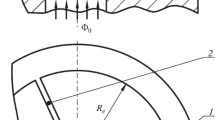Abstract
Issues of designing fluxgate magnetic gradiometers are considered. The areas of application of fluxgate magnetic gradiometers are determined. The structure and layout of a two-component fluxgate magnetic gradiometer are presented. It is assumed that the fluxgates are strictly coaxial in the gradiometer body. Elements of the classical approach to the mathematical modeling of the spatial arrangement of solids are considered. The bases of the gradiometer body and their transformations during spatial displacement of the gradiometer are given. The problems of mathematical modeling of gradiometers are formulated, basic mathematical models of a two-component fluxgate gradiometer are developed, and the mathematical models are analyzed. A computer experiment was performed. Difference signals from the gradiometer fluxgates for the vertical and horizontal position of the gradiometer body are shown graphically as functions of the magnitude and direction of the geomagnetic field strength vector.
Similar content being viewed by others
References
E. I. Krapivskii, A. N. Lyubchik, and A. A. Belikov, “Gradiometer Measurements of the Magnetic Fields of Pipelines to Monitor Their Technical Condition,” in Proceedings of the Vth International Workshop for Young Scientists Problems of Development of Mineral Resources in the I Century Through the Eyes of the Young (URAN IPKON RAS, Moscow, 2008), pp. 350–353.
A. A. Dubov, “Method for Determining the Limiting State of Metal in Stress Concentration Zones from the Magnetic Field Scattering Gradient,” in Proceedings of the II International Conference Diagnostics of Equipment and Structures Using the Metal Magnetic Memory Method, 26–28 February, 2001, pp. 51–64.
L. A. Bessonov, Theoretical Foundations of Electrical Engineering. Electromagnetic Field: Textbook (Gardariki, Moscow, 2003) [in Russian].
A. Yu. Ishlinskii, Orientation, Gyroscopes, and Inertial Navigation (Nauka, Moscow, 1976) [in Russian].
S. S. Rivkin, Stabilization of Measuring Devices on a Rocking Base (Nauka, Moscow, 1978) [in Russian].
D. G. Milovzorov and T. M. Loginova, “Gradiometers with fluxgate sensors,” in Proc. IX Intern. Scientific and Engineering. Conf. Measurement, Control, Information (Polzunov Altai State Technical University, Barnaul, 2009), pp. 75–76.
D. G. Milovzorov, T. A. Red‘kina, and A. A. Kolesnikov, “Two-Component Fluxgate Gradiometer for Controlling the Residual Magnetization of Tiny Parts,” in Proc. All-Russian Scientific and Practical. Conf. Modern Problems of Science and Education in a Technical College (Ufa State Aviation Technical University, Ufa, 2013), pp. 96–99.
D. G. Milovzorov, T. A. Redkina, and V. Kh. Yasoveev, “Gradiometer Systems Based on the Variable-Baseline Three-Component Magnetometers,” in Dinamika Slozhnykh Sistem — XXI Vek, No. 4, 25–31 (2014).
G. V. Milovzorov, D. G. Milovzorov, V. Kh. Yasoveyev, and T. A. Redkina, “Gradiometric Systems Based on Three-Component Variable-Baseline Magnetometer,” Italian Sci. Rev. 18 (9), 53–60 (2014).
T. A. Redkina, D. G. Milovzorov, and R. R. Sadrutdinov, “Errors of Gradiometers with Two-Component Fluxgate Sensors,” Vestn. IzhGTU 63 (3), 132–135 (2014).
T. A. Redkina, D. G. Milovzorov, and V. P. Melnikov, “On the Design of Gradiometers with Two-Component Fluxgate Sensors,” in All-Russian Scientific and Practical Conference Innovations in Science, Engineering, and Technology” (Udmurt State University, Izhevsk, 2014), pp. 218–219.
Author information
Authors and Affiliations
Corresponding author
Additional information
Original Russian Text © D.G. Milovzorov, V.Kh. Yasoveev, 2017, published in Avtometriya, 2017, Vol. 53, No. 4, pp. 95–103.
About this article
Cite this article
Milovzorov, D.G., Yasoveev, V.K. Mathematical modeling of fluxgate magnetic gradiometers. Optoelectron.Instrument.Proc. 53, 388–394 (2017). https://doi.org/10.3103/S8756699017040112
Received:
Published:
Issue Date:
DOI: https://doi.org/10.3103/S8756699017040112




